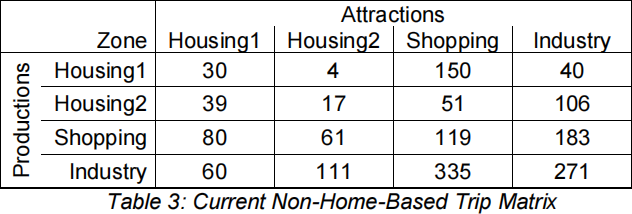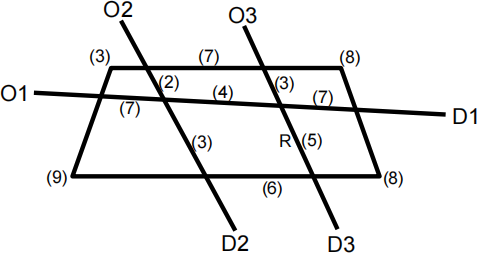CENV6153 TRANSPORT MODELLING SEMESTER 1 ASSESSMENT PAPER 2021/22
Hello, dear friend, you can consult us at any time if you have any questions, add WeChat: daixieit
SEMESTER 1 ASSESSMENT PAPER 2021/22
CENV6153
TRANSPORT MODELLING
Question 1
a) The concept of generalised cost is well established for traditional modes such as private car and public transport use, but increasingly travellers are using new modes of transport, especially for short trips. Describe the components and relative weights of a generalised cost function for a journey by a hired electric scooter. [10 marks]
b) A small town has an old trip matrix (Table 1) for daily home-based trips on a weekday (Monday to Friday). Because of recent population growth in the town, the council believes that the matrix may now be greatly underestimating the trip levels between some pairs of zones. Use the new total production and attraction values in Table 2 to update the old matrix to current trip levels.

You may accept a maximum error in any total production or total attraction value of 0.1%. [10 marks]
c) If the current weekday non-home-based trip matrix for the town is given in Table 3, calculate the complete current weekday origin-destination matrix for the town.

Question 2
a) For the uncongested road network given in Figure 1, 170 vehicles want to travel from Origin O1 to Destination D1. The perceived cost of a route is equal to the total travel time (in minutes) for the route. All turns are allowed, but a vehicle must not pass through the same junction twice on a route.

Use the Dial paths method with a spread parameter of 0.2 to estimate the flows of vehicles travelling from O1 to D1 that use the road labelled R. [10 marks]
b) A small town currently has three main routes for the 1500 vehicles per hour travelling from the west side of the town to the east side of the town. The North Route is 7 km, the Central Route is 4.5 km and the South Route is 6 km in length, with speed-flow curves as given in Figure 2.
You may assume that the perceived cost of each route for a driver is equal to the travel time for that route.

i) Use an incremental assignment method with 10 equal sized blocks to estimate the flow on the North Route [10 marks]
ii) The town council are planning major road-works which will close the Central Route for six months. Calculate the equilibrium flows on the North and South Routes while the Central Route is closed. [5 marks]
Question 3
a) A household is considering their future transport requirements as their existing car cannot be repaired. They are considering whether to buy a cheaper small car or a more expensive large car and whether they should purchase an electric vehicle (which would also mean paying for a home charger to be installed) or a diesel fuelled car. The expected costs and perceived convenience of each option are given in Table 4.

The deterministic utility of a choice is given by the formula:
U = – ( 0.004(p+c) + 0.1m + 0.05(e+f) )
Estimate the probability that the household chooses to buy a small electric car if:
(i) The four options can all be assumed to be independent [3 marks]
(ii) The size of car (large or small) and engine type of car (diesel or electric) should be considered as separate decisions. You may assume a value of λ = 0.75 when calculating any composite utilities [10 marks]
b) The city of Sydney (Australia) is currently developing a new airport on the western side of the city. Discuss (with examples) the roles of microscopic modelling, 4-stage demand modelling and GIS modelling in the design of a new airport facility such as this, and in the assessment of expected travel benefits compared to the existing (city centre) airport. [12 marks]
Question 4
a) How can departure time choice be included within a 4-stage model? [10 marks]
b) Explain the difference between fully joint tours and partial joint tours in Activity Based Models. Give an example of (and illustrate) each type of joint tour for three university students living in the same rented house. [7 marks]
c) Explain the difference between a user equilibrium and a system optimum assignment. How could a toll be used to encourage travellers to change routes towards a more system optimum assignment situation? [8 marks]
2024-01-20